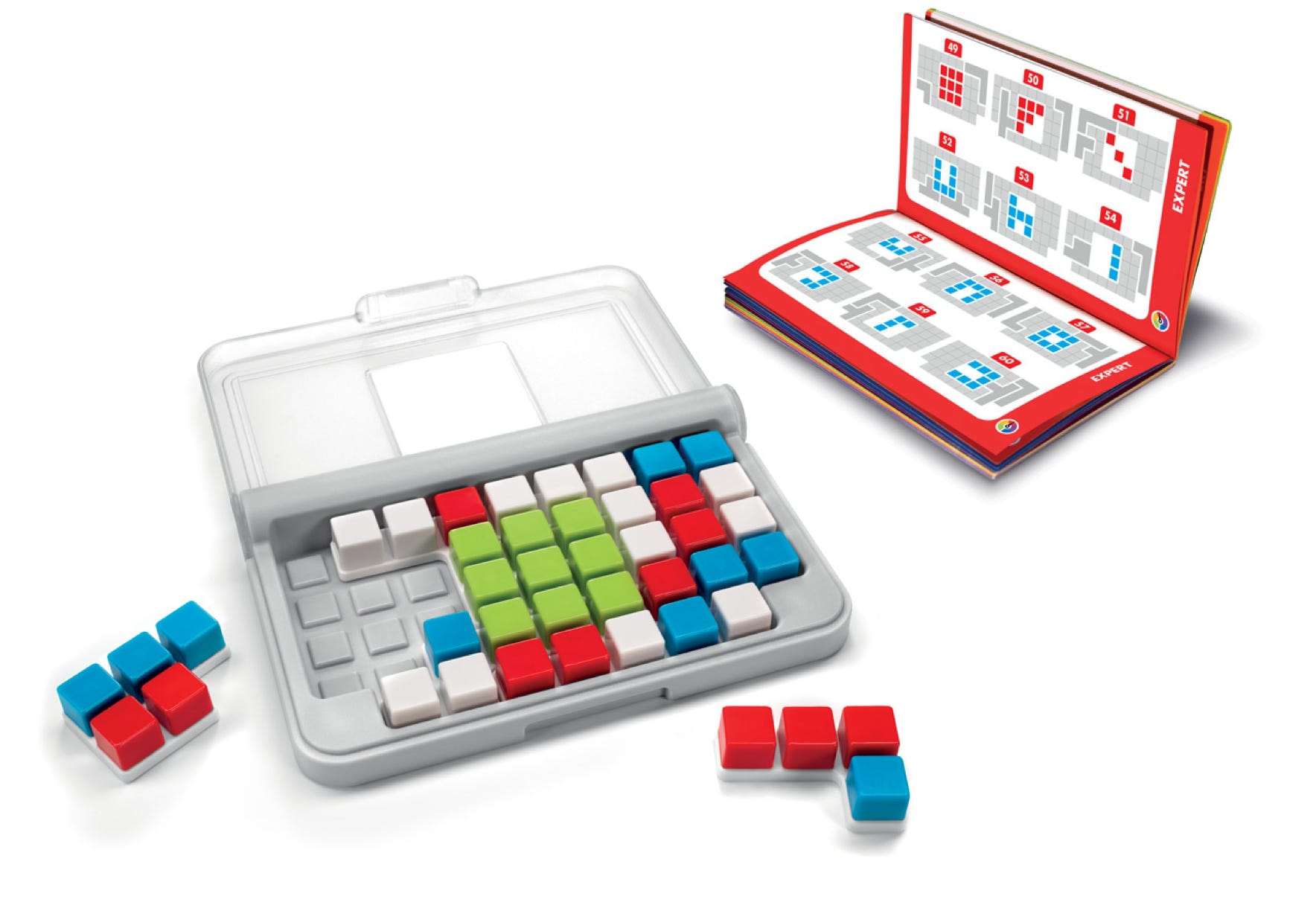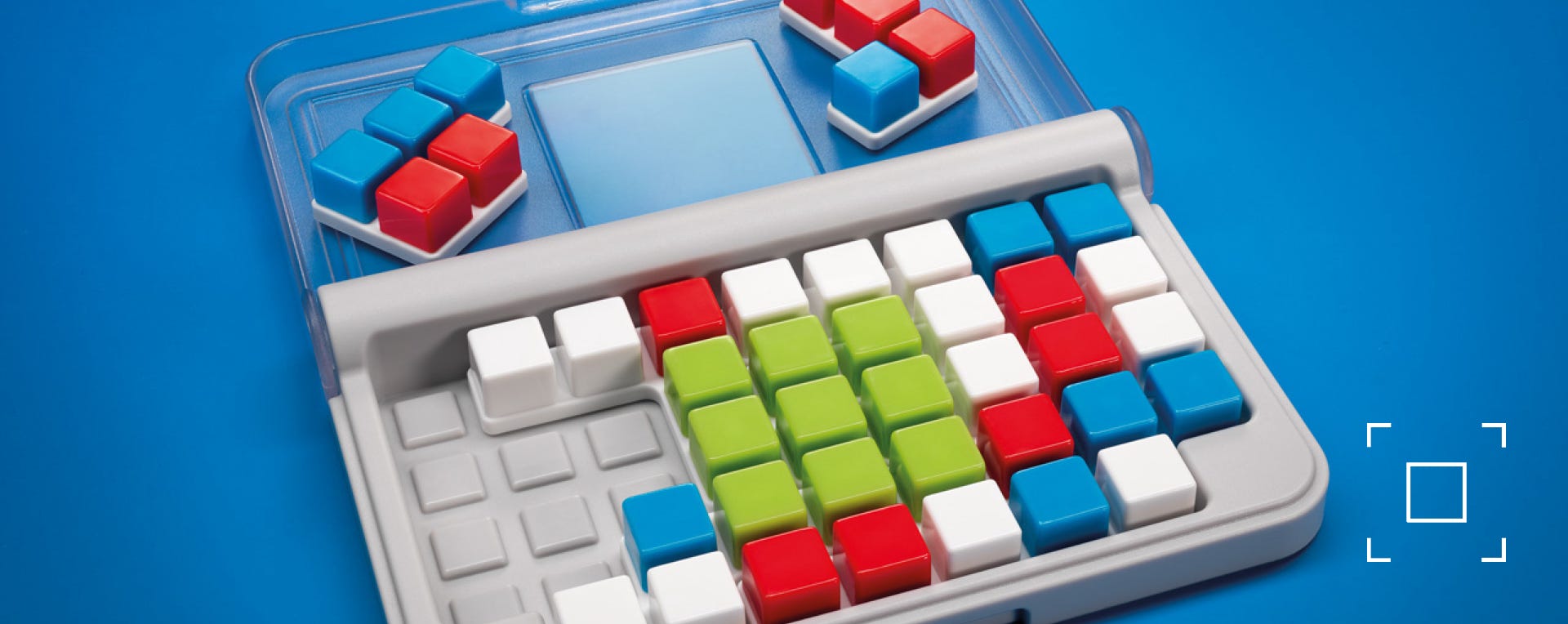
IQ-Focus
The story behind the creation of IQ-Focus
Raf Peeters, January 2017
After the very straight forward concepts like IQ-Blox and IQ-XOXO, this year I wanted to create a new IQ-puzzle that offered something really different.
THE PERFECT MATCH
All existing IQ-games I designed so far had a few things in common:
• the challenges show the position of some puzzle pieces
• each puzzle piece is made in a specific color
• the segments of each puzzle is based on a circle (except for the X shape of IQ-XOXO)
• puzzle pieces are double sided
In IQ-Focus the object of the game is still to fill up the grid, but now the challenge only shows a part of the solution. This is the 3x3 area in the middle of the game board, which is also visible through the glossy window when you close the lid. Each puzzle piece is now one-sided. The topside has little cubes in different colors. That means that a specific color is no longer tied to a specific puzzle piece. Some puzzle pieces have just 1 color, others have 2, 3 or 4 different colors. This makes identifying which part of a puzzle pieces is visible in the central 3x3 grid a lot harder. There are some similarities with Bend-it, which is also a game in pattern recognition.
The position of the colored cubes and puzzle pieces was carefully chosen, to make sure that the puzzle pieces could create a lot of different patterns in the central 3x3 grid. To avoid that you constantly need to look inside the challenge booklet, these patterns also needed to be simple, for example because they are symmetrical or because they use only 1 or 2 colors. This makes it much easier to memorize which pattern you need to create. I also wanted to have challenges with only 1 color. I managed to find a specific layout of the colors on the puzzle pieces, so that a challenge with a white, red and green 3x3 grid is possible. I couldn’t find one with 9 blue squares, but did find one with 8 blue ones and a white in the centre. But if you only know the color of 9 of the 43 cubes, it’s still very hard to figure out how to fill up the grid. So to get started I included the position of some puzzle pieces in the easier challenges. Because every puzzle piece has it’s own specific shape, I only show the outlines of these puzzle pieces. This way all challenges look consistent, showing only the central 3x3 grid in color.
In this game “white cubes” are also considered as “a color”. So when the 3x3 grid shows a white square it needs to be white. This is different to SmartCar, where white squares only indicate that the color is not revealed. When you start playing, you probably need to open en close the lid a few times, just to check where exactly if the colors indicated in the challenge are indeed visible on the right place. But after a few challenges, you know where this area is and you only do this when you want to check your solution.
NOT FOR BLOCKHEADS
IQ-Focus is definitely one of the most challenging IQ-games. If you just use trial and error, you will need a lot of patience to find the solution. But if you stay focussed on 1 specific location on the game board (the one that includes the central square of the 3x3 grid), logic and deduction will bring you much further than in most other IQ-games. So the real difficulty depends greatly on what your typical strategy is to tackle these kind of challenges.
There are with these set of puzzle pieces 8624 possible packings. Less than half of those packings have an unique pattern in the central square, so you still have plenty of options to find other interesting challenges besides the 120 shown in the challenge booklet.

example of an easy challenge/solution of IQ-Focus

example of a difficult challenge/solution of IQ-Focus

GAME RULES IQ-FOCUS
1. Select a challenge. Each challenge shows the color of the 9 squares in the central area of the game board (the 3x3 area you see through the transparent window when you close the lid). Focus on this area when solving the challenge. Squares can be red, green, blue or white.
2. The object of the game is to fit all the pieces on the game board so that the colors of the 9 central squares match what is shown in the challenge:
• All 10 puzzle pieces must be placed on the game board.
• The color of squares outside the central area is not important (and therefore not shown in challenges or solutions).
• Pieces can be placed partly inside and partly outside the central area. Only the colors of the squares inside the central area will be shown in the challenge.
3. When all puzzle pieces fit on the game board, close the lid to check if the color placements in the central 3x3 area match with the challenge. There is only 1 correct solution, which can be found at the end of the booklet.
HINTS:
• To get you started, STARTER, JUNIOR and EXPERT level challenges show the position of some puzzle pieces (dark grey) outside the central area.
• Use logic to solve IQ-Focus challenges. For example, try to find out which puzzle piece fits in the middle of the 3x3 area. This location often has the fewest possibilities and can be an ideal starting point for finding the solution to the challenge.
Website ©2017 Raf Peeters
Products and images: © Smart
